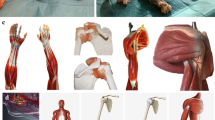Abstract
The purpose of this study was to compare the effectiveness and qualitative experience of learning gross anatomy of the pelvis and perineum (P/P) and musculoskeletal system (MSK) via cadaveric dissection to learning these same anatomical regions using the Anatomage table. The Anatomage table is an anatomical visualization system that projects male and female gross anatomical structures from human cadavers onto a life-sized touchscreen table. A crossover design was implemented. Four volunteer dissection groups, consisting of four students each, were randomly assigned to dissect P/P on the Anatomage table and MSK (upper and lower limb) not on the cadaver lab or vice versa. Participating students completed surveys before and after each lab, formative quizzes following each lab, and summative final practical exams on both the Anatomage table and in the cadaver lab. Results indicated that when studying on the Anatomage table, students were more excited before and after labs and perceived a greater degree of learning. The groups did not demonstrate a significant difference in P/P knowledge based on quiz results; however, the Anatomage group had a significantly higher mean score on quizzes in MSK anatomy. Finally, the practical exam results suggest that for some anatomical regions, students may perform similarly regardless of the modality on which they were instructed.

Similar content being viewed by others
References
Kozma RB. National policies that connect ICT-based education reform to economic and social development. Human Technology: An interdisciplinary journal on humans in ICT environments. 2005;1(2):117–156.
Resta P, Laferrière T. Technology in support of collaborative learning. Educ Psychol Rev. 2007;19:65–83.
Buckenmeyer JA, Barczyk C, Hixon E, Zamojski H, Tomory A. Technology’s role in learning at a commuter campus: the student perspective. J Furth High Educ. 2016;40(3):412–31.
Roblyer MD. Integrating educational technology into teaching. 3rd ed. Prentice Hall: Upper Saddle River; 2002.
DiLullo C, McGee P, Kriebel RM. Demystifying the millennial student: a reassessment in measures of character and engagement in professional education. Anat Sci Educ. 2011;4(4):214–26.
Ghosh SK. Cadaveric dissection as an educational tool for anatomical sciences in the 21st century. Anat Sci Educ. 2017;10(3):286–99.
Serageldin I. Ancient Alexandria and the dawn of medical science. Glob Cardiol Sci Pract. 2013;4:395–404.
Fulton JF. History of medical education. Br Med J. 1953;2(4834):457–61.
Yammine K, Violato C. A meta-analysis of the educational effectiveness of three-dimensional visualization technologies in teaching anatomy. Anat Sci Educ. 2015;8(6):525–38.
Hildebrandt S. Lessons to be learned from the history of anatomical teaching in the United States: the example of the University of Michigan. Anat Sci Educ. 2010;3(4):202–12.
McBride JM, Drake RL. National survey on anatomical sciences in medical education. Anat Sci Educ. 2018;11(1):7–14.
Küçük S, Kapakin S, Göktaş Y. Learning anatomy via mobile augmented reality: effects on achievement and cognitive load. Anat Sci Educ. 2016;9(5):411–21.
McHanwell SM, Davies DC, Morris J, Parkin I, Whiten S, Atkinson M, et al. A core syllabus in anatomy for medical students - adding common sense to need to know. Eur J Anat. 2007;11:3–18.
Op den Akker JW, Bohnen A, Oudegeest WJ, Hillen B. Giving color to a new curriculum: body paint as a tool in medical education. Clin Anat. 2002;15(5):356–62.
Ahmed K, Rowland S, Patel V, Khan RS, Ashrafian H, Davies DC, et al. Is the structure of anatomy curriculum adequate for safe medical practice? Surge. 2010;8(6):318–24.
Kraszpulska B, Bomkamp D, Brueckner-Collins J. Benefits of traditional cadaveric dissection in a digital world: medical and dental students’ perspectives. Med Sci Educ. 2013;23(1):27–34. https://doi.org/10.1007/bf03341800.
Goldman E. Building a low-cost gross anatomy laboratory: a big step for a small university. Anat Sci Educ. 2010;3(4):195–201.
Mayfield CH, Ohara PT, O’Sullivan PS. Perceptions of a mobile technology on learning strategies in the anatomy laboratory. Anat Sci Educ. 2013;6(2):81–9.
McLachlan JC, Patten D. Anatomy teaching: ghosts of the past, present and future. Med Educ. 2006;40(3):243–53.
Stepan K, Zeiger J, Hanchuk S, Del Signore A, Shrivastava R, Govindaraj S, et al. Immersive virtual reality as a teaching tool for neuroanatomy. Int Forum Allergy Rhinol. 2017;7(10):1006–13.
Sugand K, Abrahams P, Khurana A. The anatomy of anatomy: a review for its modernization. Anat Sci Educ. 2010;3(2):83–93.
Johnson EO, Charchanti AV, Troupis TG. Modernization of an anatomy class: from conceptualization to implementation. A case for integrated multimodal-multidisciplinary teaching. Anat Sci Educ. 2012;5(6):354–66.
Mitchell BS, Stephens CR. Teaching anatomy as a multimedia experience. Med Educ. 2004;38(8):911–2.
Elizondo-Omaña RE, Guzmán-López S, García-Rodríguez ML. Dissection as a teaching tool: past, present and future. Anat Rec B New Anat. 2005;285(1):11–5.
Fredieu JR, Kerbo J, Herron M, Klatte R, Cooke M. Anatomical Models: a Digital Revolution. Med Sci Educ. 2015;25(2):183–94. https://doi.org/10.1007/s40670-015-0115-9.
Estai M, Bunt S. Best teaching practices in anatomy education: a critical review. Ann Anat. 2016;208:151–7.
Hisley KC, Anderson LD, Smith SE, Kavic SM, Tracy JK. Coupled physical and digital cadaver dissection followed by a visual test protocol provides insights into the nature of anatomical knowledge and its evaluation. Anat Sci Educ. 2008;1(1):27–40. https://doi.org/10.1002/ASE.4.
Hall S, Stephens J, Parton W, Myers M, Harrison C, Elmansouri A, et al. Identifying medical student perceptions on the difficulty of learning different topics of the undergraduate anatomy curriculum. Med Sci Educ. 2018;28(3):469–72. https://doi.org/10.1007/s40670-018-0572-z.
Acknowledgments
We would like to acknowledge Klara Papp Ph.D. for her invaluable support in this study.
Author information
Authors and Affiliations
Corresponding author
Ethics declarations
Ethical Approval
The protocol for this study was given exempt status by the Institutional Review Board of Case Western Reserve University (IRB# 2015-1035).
Informed Consent
Informed consent was obtained from all individual participants included in the study.
Conflict of Interest
The authors declare that they have no conflicts of interest.
Additional information
Publisher’s Note
Springer Nature remains neutral with regard to jurisdictional claims in published maps and institutional affiliations.
Rights and permissions
About this article
Cite this article
Baratz, G., Wilson-Delfosse, A.L., Singelyn, B.M. et al. Evaluating the Anatomage Table Compared to Cadaveric Dissection as a Learning Modality for Gross Anatomy. Med.Sci.Educ. 29, 499–506 (2019). https://doi.org/10.1007/s40670-019-00719-z
Published:
Issue Date:
DOI: https://doi.org/10.1007/s40670-019-00719-z




